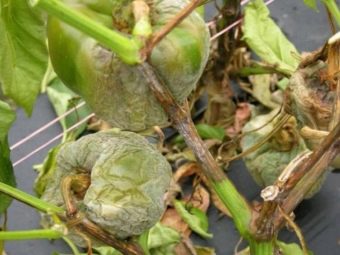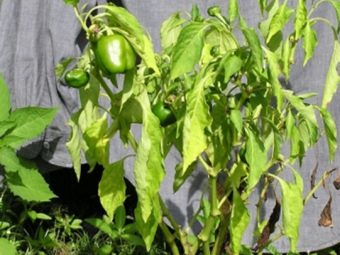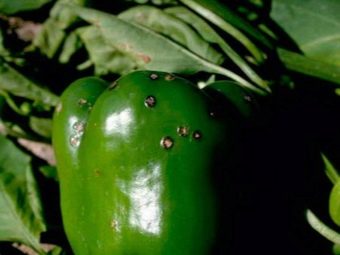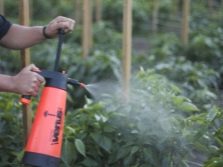Pepper diseases: signs, treatment and folk remedies for harmful insects
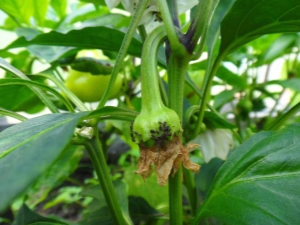
Many grow peppers, because it is not only tasty, but also incredibly healthy vegetable. In order for the harvest to be rich, it is necessary to competently care for the seedlings and to ensure that they are not attacked by diseases and various pests. With micronutrient deficiencies, they are at great risk, so you should get rid of diseases in a timely manner and carefully inspect the plant for shortages.
What are the?
Each vegetable grower is aware that sweet pepper seedlings are trapped by a large number of different diseases and insects that can destroy plants. If you start to treat the vegetable on time, you can save it from death and in future get a decent harvest. Most often, the culture starts to hurt if it is improperly looked after. There are several types of diseases.
Fungal
Young shoots exposed to black leg infection. If the plant becomes infected, its stems become thinner and soon begin to dry and break. Peppers can get sick due to high humidity or insufficient light. The pathogen is in contaminated soil, from it passing to the seedlings.
In the fall, the plant can be affected by Alternaria. On the leaves you can see black or brown spots. The yield of plants decreases, in some cases the fruits may be damaged.
If small brown spots have appeared on different parts of the pepper, which become extremely large very quickly, the vegetable grower is faced with late blight. On the reverse side of the sheet plate you can see a bloom of white. It is a spore of fungi that are dangerous to the plant. Stems are covered with brown blurred spots that have no boundaries. For a week, the disease can spread greatly. If you do not treat seedlings, it entails her death.
If the peppers grow too thick and too wet, there may be a risk of powdery mildew. It can be found in young plants. On top of the leaf plate are large chlorotic spots that change the shape of the leaf. They extremely quickly begin to merge, which causes the plants to dry out and die.
The disease, the development of which occurs with the help of the fungus, located inside the stem - fusarium pepper wilt. It contributes to the formation of stripes of red-brown color, due to which the seedlings can die. Lower leaves quickly fade, but before that they become pale.
Bacterial
Diseases of this type do not have any specific distinctive features. Quite often, even experienced gardeners confuse them with other types of diseases, so it is extremely difficult to establish the correct diagnosis. Such infections can cause heavy damage to sweet bell peppers both in the greenhouse and in the open field. It is necessary to take up the treatment of plants in a timely manner.
Inside the seedlings bacteria appear due to mechanical damage in plant tissues. Carriers are animals, pests and birds. If the conditions for bacteria are comfortable, they can be in the ground, so before planting the seeds, it is important to disinfect the soil and the seeds themselves so that this problem can bypass the seedlings.
Black bacterial spotting is a disease that can harm seedlings when the first shoots appear. On the leaves and stem, you can see black spots, which soon become large and cover the whole plant. Infected seedlings should be removed.
Bacterial wilt harms the vascular system of plants. These bacteria do not allow the peppers to gain access to the necessary nutrients, and the seedlings subsequently become sluggish.
A similar problem is fairly easy to detect. It is necessary to slightly incise the stem. If a white liquid begins to appear, it means that the plant is infected.
Also, the vascular system may suffer due to mild bacterial rot.The disease affects the entire plant, which will soon die. The stem changes color, inside it becomes completely empty. The leaves turn pale and fall off. The disease can spread extremely quickly if humidity is elevated.
If the temperature and humidity indicators are high and the plant thickens are strong, there is a risk of infection by bacterial cancer. Carriers of infection are various pests, animals and vegetable growers themselves. On any part of the plant dark brown spots can appear, which soon begin to merge into one large and become covered with a brown crust, the leaf becomes hard.
If the leaves of the pepper become pale and corrugated, the plant suffers from verticillus. The disease kills pepper in 2-3 days.
Viral
Such diseases cause a variety of viruses that get on the peppers with insects or from the soil. Each disease of this type has distinctive features.
Tobacco mosaic may appear where there is no good light and there is high humidity. Plants are contaminated due to poor quality soil or seeds. Its signs - seedling leaves change color, become bright and variegated. Soon they begin to turn black and fall. Peppers do not develop well and bear deformed fruits.
Despite the name - cucumber mosaic or curly, the disease affects not only cucumbers, but also Bulgarian peppers. There are several forms of the disease:
- Transient form. Plants lose their internal pressure, start to dry out extremely quickly, but have a green color.
- Brown Shoots and leaves wither, dry out and turn brown. The disease begins at the bottom of the plant and gradually moves upwards.
- Yellow Shoots and stems become yellow and deform. Plants do not grow, there are no fruit ovaries.
- Dwarf. Peppers cannot grow normally, have small, gnarly leafy plates, shortened shoots, a small number of ovaries. Fruits curves, irregular shape.
If red strokes or stripes are visible in the upper part of the pepper, it means that the plant is struck with a spear. The leaves change shape, fragile, brittle.
How to cure?
Virtually every disease can be cured, if you pay attention to the symptoms in a timely manner. There are diseases that do not cure, in which case you should remove the infected plant.
It is rather difficult to cure a black leg. It is impossible to completely get rid of this disease, therefore, before the seeds are planted, it is necessary to use a dark solution of potassium permanganate, which needs to be sprayed with soil. Plants should be sprayed with a five-percent solution of colloidal sulfur or potassium permanganate (five grams per bucket). Also effective protection is a one percent solution of Bordeaux liquid.
Alternariosis is treated with Cumulus, Tiovit and Jet. You must carefully read the instructions of drugs. Spray the plants should be 2-3 times per season.
If the plant is ill with late blight, you need to get rid of it. Then take steps to prevent other peppers from becoming infected. They should be treated with "Alirin-B" (two tablets per liter of water) or "Oxyhom" (four grams per two liters).
If the seedlings are contaminated with powdery mildew, they should be destroyed, and the earth should be disinfected with a solution of dark pink manganese. The remaining plants are treated with Radomil Gold.
In order for peppers not to fall ill with Fusarium wilt, it is worthwhile to disinfect the seeds with the help of “Fundazole” (0.1 g of the drug per 10 g of seeds). Affected peppers must be excavated and burned.
To avoid infection with black bacterial blotch, seeds must be processed before planting them. This is done with a weak solution of potassium permanganate or Fitolavin-300. The soil is prepared - it is frozen, steamed.If the first symptoms of the disease are noticeable, the plants are sprayed with a one-percent solution of Bordeaux mixture.
So that the vegetable grower does not encounter bacterial wilting, it is worth planting seeds with two cloves of garlic before planting seeds. Garlic must be crushed and mixed with water. Seeds are placed in the medium for half an hour. To grow plants in a pot or in a polycarbonate greenhouse, disinfect the soil with a strong solution of potassium permanganate. If the peppers are still affected, they should be removed and the unaffected should be treated with preparations containing copper (20 grams of copper sulfate should be dissolved in ten liters of water).
How to deal with other bacterial diseases:
- A timely treatment of the soil and seeds with the Fitosporin-M agent (two grams per liter) will help to avoid soft bacterial decay. Affected peppers are removed.
- If the plants are affected by bacterial cancer, they should be removed, and the rest of the seedlings treated with copper-containing means (30 grams of oxychloride per ten liters). The soil on which the infected plants were located should be treated with methyl bromide or changed.
- Verticillosis cannot be cured, so if the plant is affected, it is burned and the soil replaced.
In order not to encounter tobacco mosaic, it is worth treating the soil and seeds with a solution of potassium permanganate (five grams per ten liters). Infected peppers are removed, and those that remain are treated with an aqueous solution of milk (1 to 10). Also, two or three drops of iodine are added to the product.
In order for the plants not to be infected with curl, it is necessary to treat the soil with a solution of potassium permanganate. Do not forget that in time removed weeds and the fight against attacks of insect vectors also help to fight the disease. The diseased plant is removed, the healthy ones are treated with Aktara, Aktelika, Akarina, Fitoverma.
If the plants are damaged by a streak, they should be disposed of, and the soil should be disinfected with a dark pink solution of potassium permanganate. Healthy seedlings are treated with a 15% trisodium phosphate solution (100 grams per liter).
Pest protection
There are several types of pests that can harm peppers seedlings.
Aphid
The most dangerous insect that drinks the sap of the plant, which contributes to its death. To rid the pepper of the pest, it is necessary to treat it with insecticides (karbofos or Celtan), dissolving a tablespoon of the product in ten liters of water. Plants are sprayed before flowering and after it. Processing should stop when they begin to bear fruit.
There is an effective folk remedy that helps get rid of aphids. A glass of wood ash or a glass of tobacco dust is poured into a volume bucket, filled with boiling water and left for 24 hours. Before spraying the seedlings, the product must be thoroughly mixed. Next, it is filtered, there is added a tablespoon of liquid soap. Plants are sprayed early in the morning.
Spider mite
This pest can suck the juice from the leaves of pepper, which contributes to its withering and death. Often located at the top of the plant. To combat the need to prepare a solution. A glass of garlic is minced with a meat grinder and mixed with ten liters of water. The tool is filtered, the seedlings are sprayed.
Slugs
This pest gnaws fruit, eats leaves. But it can also be fought with by popular means and methods In order that the insect does not appear, you need to care for the plantings, to monitor their cleanliness. If the weather is sunny and hot, the soil should loosen by three to five centimeters. For pollination of the soil should take ground bitter pepper or dry mustard (one teaspoon of funds per several square meters).
More tips for plant conservation and harvest:
- In early autumn, open ground is deeply plowed, the soil of greenhouses is being dug up.
- In March, the soil in the greenhouse should be treated with bleach. This will help fight ticks.
- When the seedlings grow, you need to constantly loosen the ground.
- From the remnants of vegetables should make traps that will get rid of wireworms, as well as to lay in the ground "Basudin", preventing the attack of the bear.
- In order for the seedlings not to attack the thrips, you need to constantly inspect it for the appearance of insects, and then use insecticides. It is necessary to process it with these means several times during the season (when the first leaves appear and before the flowering period).
- A proven effective remedy that repels any insect - an infusion of tobacco or ground red pepper.
Gardeners tips
It is necessary to carry out prevention to get rid of the occurrence of problems. It is better to avoid infections or insect attacks. There are recommendations that will allow growers not to worry about the safety of seedlings:
- In autumn, the soil must be carefully dug up to 30 centimeters deep. This process is a standard procedure, which eliminates the seedlings from a large number of various fungal diseases and many dangerous insects, which subsequently die from low temperatures.
- It is necessary to follow the rules of crop rotation. This is an extremely important approach in the cultivation of this crop. It is strictly forbidden to plant peppers for several years in the same place. Also, they can not be planted after any other Solanova. If you treat this carelessly, the disease will accumulate and the infection of the culture will be one hundred percent.
- The next extremely important procedure is correct watering. The best option is drip irrigation. If pereuvlazhnyat soil, putrid phenomena appear on the plant. It is necessary to water the seedlings as carefully as possible. If there is a large amount of precipitation, watering should stop.
These simple rules will help prevent the emergence of virtually all possible diseases. It is important to take the cultivation of vegetables seriously and responsibly, otherwise the peppers will not give a good harvest and will die.
It must be remembered that timely proper care contributes not only to healthy growth and the normal development of the plant, but also a great harvest.
All about diseases and pests of pepper, see the following video.




